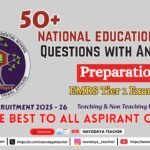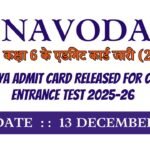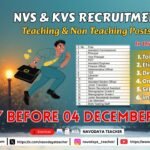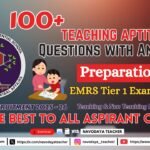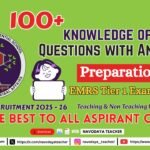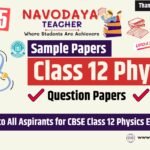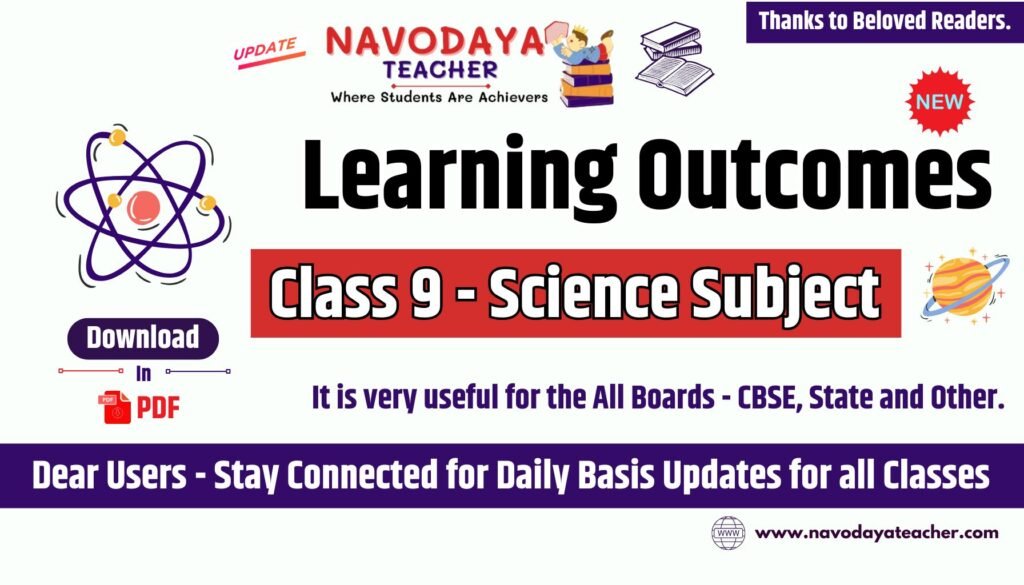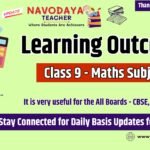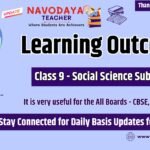In this article we providing information regarding latest Learning Outcomes for Class 9 Science Subject in PDF
Learning Outcomes for Class 9 Science Subject in PDF 2024
The learner—
- Differentiates materials, objects, organisms, phenomena, and processes, based on properties or characteristics, tissues, distance and displacement, speed and velocity, balanced and unbalanced forces, elements, compound and mixture, solution, suspension and colloid, isobars and isotopes, etc.
- Classifies materials, objects, organisms, phenomena, and processes, based on properties or characteristics, such as, classification of plants and animals under various hierarchical sub-groups, natural resources, classification of matter based on their states (solid/liquid/gas) and composition (element/compound/ mixture), etc.
- Explains processes and phenomena, such as, functions of different organelles, spread of diseases and their prevention, effect of force on the state of motion of objects, action and reaction, rotation and revolution of planets and satellites, conservation laws, principle of separation of different gases from air, melting, boiling, freezing, how bats use ultrasonic waves to catch prey, etc.
- Draws labelled diagrams, flow charts, concept maps, graphs, such as, biogeochemical cycles, cell organelles and tissues, human ear, distance-time and speed-time graphs, distribution of electrons in different orbits in an atom, process of distillation and sublimation, etc.
- Uses scientific conventions, symbols, and equations to represent various quantities, elements, and units, such as, SI units, symbols of elements, formulae of simple compounds, chemical equations, etc.
- Measures physical quantities using appropriate apparatus, instruments, and devices, such as, weight and mass of an object using spring balance, mass using a physical balance, time period of a simple pendulum, volume of liquid using measuring cylinder, temperature using thermometer, etc.
- Applies learning to hypothetical situations, such as, weight of an object at moon, weight of an object at equator and poles, possibility of life on other planets, etc.
- Derives formulae, equations, and laws, such as, mathematical expressions for Newton’s second law of motion, law of conservation of momentum, expression for force of gravity, equations of motion from velocity-time graphs, etc.
- Designs models using eco-friendly resources, such as, 3D model of a cell, water purification system, stethoscope, etc. Y exhibits values of honesty, objectivity, rational thinking, freedom from myths, superstitious beliefs while taking decisions, respect for life, etc., such as, records and reports experimental data exactly, myth that sexually transmitted diseases are spread by casual physical contact, belief that vaccination is not important for prevention of diseases, etc.
- Communicates the findings and conclusions effectively, such as, those derived from experiments, activities, and projects both in oral and written form using appropriate figures, tables, graphs, and digital forms, etc.



